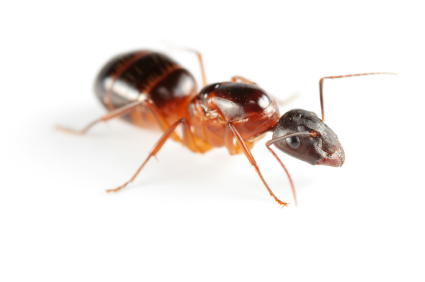Unlike termites, carpenter ants do not feed on wood. However, their tendency to tunnel through the material to construct nests can be incredibly destructive. Over time, their activities can cause damage that goes beyond cosmetic and endangers the building’s structural integrity. With the stakes so high, it’s vital that any carpenter ant infestation be dealt with immediately. How do you know if the insects that you’ve spotted marching across your property are carpenter ants?
Color
There are more than 20 species of carpenter ants in the United States, and a carpenter ant’s coloration can vary depending on its species. Most are black, but some species are red, brown, orange or yellowish in color.
Size
Carpenter ants are generally bigger than your typical ant. In fact, they can be roughly 15 times larger than common black ants. However, their size can vary widely depending on their species and their role in the colony. When it comes to carpenter ants, workers tend to measure somewhere between 6.5 millimeters and 13 millimeters in length. Swarmers and queens can reach lengths of 25 millimeters.
Antennae
Carpenter ants have heart-shaped heads that are topped by two antennae. These sensory appendages don’t simply stick straight out. They are elbowed, or bent.
Waist
When trying to decide if the insect that you’re eyeing up is a carpenter ant, look at its middle. While many bugs have boxy, rectangular bodies, ants have a defined waist. All ants have bodies that consist of a head, thorax and abdomen. Behind the head, six legs sprout from the thorax. Then, a narrow waist called a petiole marks the transition to the abdomen. While some ants have bumpy thoraxes, carpenter ants have smooth, rounded ones. In addition, they have only a single node on their petiole.
Wings
Although the image that springs to mind when most people are asked to picture an ant generally lacks wings, winged ants do emerge in the spring and summer months and set out to establish new colonies. These swarmers have two pairs of wings to facilitate their travels. Winged ants are often mistaken for termites, but a close look at the wings can help you tell which insect is which. Termites have four wings that are equal in size and shape. In contrast, ants have front wings that are longer than their rear wings.
Carpenter ants can do a lot of damage, so it’s crucial that you seek professional assistance promptly if you suspect a problem. A family-owned company that’s been serving New Jersey homes and businesses for nearly 40 years, Abarb Pest Services is ready to help you tackle even the toughest pest issue. Contact us today to request a free estimate.
